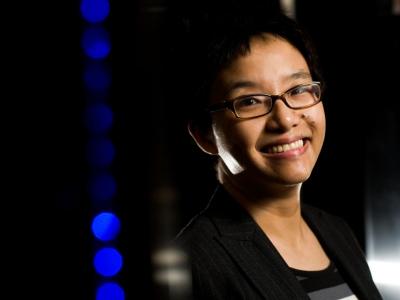Better Modeling Through SciDAC
An interdisciplinary collaboration identifies previously overlooked errors in atmospheric models
This story was originally published on the Pacific Northwest National Laboratory (PNNL) website.
By Beth Mundy, PNNL
Hui Wan wants to help create more accurate computer-based models of the Earth’s atmosphere to provide more reliable weather and climate predictions.
Rapid increases in computing power have allowed scientists to use numerical models of the atmosphere at greater resolutions, capturing additional crucial details of important phenomena like the life cycles of clouds and storms. However, not all computational methods can arrive at an answer as accurate as expected from the massive, high-resolution simulations. As Wan learned during her atmospheric science training, a solution to that problem could involve more extensively and rigorously using techniques from a different field: applied mathematics.
Now Wan leads a multi-institutional team of atmospheric scientists and mathematicians who combine their knowledge of atmospheric physics and concepts from applied mathematics to understand sources of error in computer-based atmospheric models, like the atmospheric component of the U.S. Department of Energy’s Energy Exascale Earth System Model (E3SM). The goal of Wan’s team is to improve atmospheric models to produce more accurate results with less computing cost.
This project is the latest collaboration led by Pacific Northwest National Laboratory (PNNL) through the U.S. Department of Energy’s Scientific Discovery through Advanced Computing (SciDAC) program. SciDAC projects emphasize interdisciplinary collaboration as a key aspect of success.
A successful equation for SciDAC collaboration

For 20 years, SciDAC has brought applied mathematicians and computer scientists together with scientists working on challenging problems in other fields. The goal has been to create deeply collaborative teams that use supercomputing resources to advance science.
PNNL researchers have been part of SciDAC collaborations since the program’s beginning, contributing their expertise in computer science, mathematics, Earth science, and atmospheric science, among other fields.
Atmospheric modelers and mathematicians each speak their own language, with different terms and fundamental concepts. Bridging the gap to reach mutual understanding involved significant patience and effort, knowing that the combined expertise could lead to an integrated team capable of developing deeper insights into modeling problems.
“During the first year of the project, we had tutorials where we taught each other about different key concepts and terms in our disciplines. Hui has done a great job digging into details across all aspects of the research,” said Panos Stinis, a PNNL mathematician involved in the SciDAC project.
In the course of their discussions, the team realized they had different definitions of a fundamental term: model. According to Wan, mathematicians tend to refer to the equations that describe the underlying physical processes as the model. However, atmospheric scientists talk about the computer code that solves the equations as the model.
Solving this communication problem involved learning how to be specific about each portion of the project, referring to equations and code rather than “model.” This new shared language allows the interdisciplinary team to communicate more effectively about the aspects of their project and make smoother progress.
For instance, the enhanced clarity helped the team explore how the applied mathematics concept of error reduction rate, known as convergence, is relevant to challenges in atmospheric modeling.
“Just because I as an atmospheric scientist don’t know how to do it, doesn’t mean a mathematician can’t,” Wan said.
Using more rigorous mathematics in climate

Last fall, Wan’s team published a pair of proof-of-concept papers focused on how using a carefully selected, rigorous mathematical framework could improve the accuracy of the code’s output. These papers, published in The Journal of Advances in Modeling Earth Systems, represented the culmination of the first phase of the collaboration.
Articles from the project have landed in a mixture of national and international journals focused on weather and climate. “We have mathematicians publishing as lead authors in atmospheric science journals, which really shows how collaborative this project is,” said Wan. This demonstration of collaboration represents a key metric of success for the SciDAC program.
In these papers, the team demonstrated that convergence is relevant conceptually and practically to models of the atmosphere, despite being generally overlooked by the atmospheric physicists who work on the small-scale physics portions of models. They showed that modern, rigorous techniques from applied mathematics can be implemented in portions of E3SM and other global Earth system models in a meaningful and practical way to improve these large-scale predictions.
Looking toward continued collaboration through SciDAC
With the initial phase of the collaboration successfully completed and the team enthusiastically working on a second phase, Wan is excited for the future. Their work will become more efficient, she said, now that the researchers speak the same language and better understand each other’s disciplines.
The team plans to continue developing new numerical methods that can be used in E3SM. Demonstrating that other advanced concepts or methods from applied math can improve atmospheric representations in full, complex Earth system models is an outcome that would be very exciting for the team. They hope their results will encourage more researchers to carry out similar interdisciplinary work.
“While challenging, this project has been incredibly rewarding,” said Wan. “We push each other to ask deep questions and think critically. We’ve been able to have more impact on global Earth system models working together than we could have independently.”

